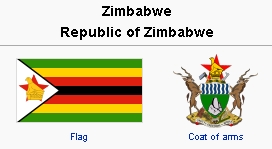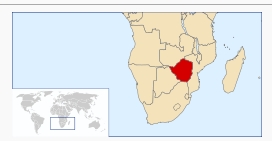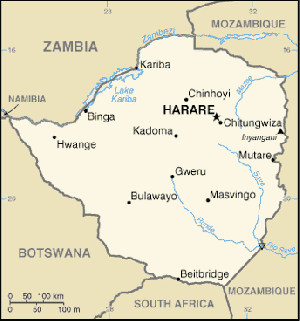Zimbabwe


Zimbabwe is a landlocked republic in south central Africa, located on the southern African plateau and surrounded by Mozambique, Zambia, Botswana, and South Africa. It had a population of 8.5 million (1986); 12.8 million (2005) with a 4.4 percent (1986); 0.51 percent (2005) annual growth rate, and it covers an area of 150,804 sq. miles (390,582 sq. km; making it slightly larger than Montana). Its people, basically of Bantu background, consist of 30 ethnic groups, of which the largest is the Shona people (66 percent) and second largest the Ndebele people (18 percent). Zimbabwe became independent in 1980 after 14 years of warfare by black nationalists against the white minority government. The two Anabaptist-oriented organizations that have been active in Zimbabwe are the Ibandla Labazalwane Kukristu e-Zimbabwe (Brethren in Christ Church) (since 1898) and Mennonite Central Committee (since 1976).
The Ndebele people, a branch of the Zulu tribe, moved north in the first half of the 19th century, partly because of the intransigence of Zulu leadership, partly because of the expansion of the Dutch Boers, and partly as an expression of their expansionistic ambition. They took possession of much of what is today Zimbabwe, subduing local tribes and gaining some domination over the Shona people. They called their new homeland Amandebeleland (anglicized as Matebeleland). Subsequently, the British under Cecil Rhodes and his British South Africa Company claimed the territory and secured it through two wars (1893-1894, and 1896), in which they defeated the Ndebele and allied forces, driving the last of the warriors into the Matopo Hills. It was in those hills that the Brethren in Christ began their missionary work in 1898.
The first Protestant missionary in the area was the famous Robert Moffat of the London Mission Society. He visited the land in 1829 and later in 1859 he and members of his family established a permanent work. It was not, however, until the activity of Cecil Rhodes that the missionary movement sharply focused its attention on what came to be called Southern Rhodesia. The early mission societies to work in the country included the Church Mission Society (1890, British), Wesleyan Methodists (1890, British), Salvation Army (1891), American Board of Commissioners for Foreign Missions (1893), Seventh Day Adventists (1895), Methodist Episcopal Church (1895, American), South Africa General Mission (1897), and the Brethren in Christ (1898).
Zimbabwe became independent as a part of the world-wide nationalistic independence movement following World War II. In 1923 the claims of the British South Africa Company were turned over to the British government and Southern Rhodesia became a self-governing British colony with a white minority government. The Federation of the Rhodesias and Nyasaland, which was formed in 1953, broke up in 1963 when majority (black) rule was established in Nyasaland (Malawi) and in Northern Rhodesia (Zambia). In 1965, Southern Rhodesia's then Prime Minister, Ian Smith, seceded from the British Empire and declared [Southern] Rhodesia an independent nation. The growing ferment for independence within the black majority issued in a long and intense guerrilla war waged by the black nationalistic Patriotic Front against the government. The Patriotic Front consisted of a number of political and military parties; the largest groups were Robert Mugabe's Zimbabwe African National Union (called ZANU, Shona-based) and Joshua Nkomo's Zimbabwe African People's Union (known as ZAPU; Ndebele-based). The relationship between these two groups was tenuous and fraught with tension. On 18 April 1980 independence came and Southern Rhodesia became Zimbabwe. Mugabe was elected prime minister. The result has been, rooted in pre-British Ndebele domination of the Shona people, which the Ndebele minority has not always fared so well. Although the Brethren in Christ (BIC) membership was largely Ndebele in background, the BIC has grown significantly in the last few years. Able Brethren leadership has helped the church to transcend tribal loyalties.
It was the relief needs caused by the guerrilla war that brought the Mennonite Central Committee (MCC) to Zimbabwe in 1980. The aim was to deal first with the emergency needs and then move on to resettlement and reconstruction projects. MCC worked closely and in consultation with the Brethren in Christ Church of Zimbabwe. The first emergency efforts consisted of aiding Zimbabwean refugees living in the surrounding countries of Zambia, Botswana, and Mozambique. Further activities involved providing maize and beans for needy people in Zimbabwe, such food being distributed by the Christian Care network (the service arm of the Christian Council of Zimbabwe). MCC also gave some money to Christian Care for the purchasing of seed, tools, and fertilizer, and funded the salary for a Brethren in Christ national serving on the Christian Care staff. The emergency phase of the work was coming to an end when Zimbabwe, along with much of sub-Sahara Africa, experienced drought and famine (1981-1984).
In response, MCC sent a large shipment of wheat, powdered milk, vegetable oil, and beans from North America to Zimbabwe; the material was distributed by Christian Care. Subsequently, 5,000 metric tons of wheat was shipped, exchanged for maize, and passed on by the same organization. In addition, a shipment of clothing and blankets was sent and shared through the BIC and Christian Care. Sheets, towels, and blankets were provided for the Brethren in Christ hospitals. The widespread rains of 1985 resulted in a record harvest meeting the food needs of the nation, but the limited rain in southeast Zimbabwe in 1986 caused a food shortage there.
The war for independence disrupted many aspects of the Zimbabwean BIC schools, hospitals, and churches which were closed; white missionaries had to leave the country. MCC assisted the BIC by providing professional staff for the social services of the brotherhood. During 1981 and 1982, an MCC medical administrator worked with the church in reopening and staffing two hospitals. Subsequently, two MCC nurses worked in a Brethren in Christ hospital and aided in some medical clinics. One MCC volunteer worked in the area of nutrition, and a physiotherapist was placed at the National Rehabilitation Center near Harare for a short period of time. MCC also provided funding to Disabled Persons International and made a further contribution by providing teachers for Brethren in Christ schools, central for secondary schools. The projection was to continue to supply teachers as needed. MCC, through its child sponsorship program, paid the school fees for needy students (65 students were sponsored 1982-1985).
Food shortages brought into focus the need for improved agriculture. Brethren in Christ farms were not adequately staffed because of the war. MCC provided one agriculturalist from 1982 to 1986. An agriculturalist, assigned to animal husbandry, began work in 1987. MCC aided the BIC in other ways: funding repair of a water dam at a church station; funds to improve water, communications, and housing at another station; funding the salary of an administrator for one year to reinstate BIC religious programming; helping in the BIC central office in Bulawayo; assisting office staff at the BIC Ekuphileni Bible Institute; and providing resource people to conduct peace seminars in BIC churches in the Bulawayo area. MCC continued to work in Zimbabwe.
The Mennonite World Conference Assembly in 2003 was held for the first time in Africa, at Bulawayo, Zimbabwe. In 2006 the Ibandla Labazalwane Kukristu e-Zimbabwe had 33,453 members in 317 congregations.
Bibliography
Barrett, David B., ed. World Christian Encyclopedia. Oxford Press, 1982.
Hull, Richard W. "Zimbabwe's Elusive Quest for Unity." Current History 85 (May 1986): 209-12.
Johnson, Patrick. Operation World. W.E.C. Publications, 1986.
Kane, J. Herbert. A Global View of Christian Missions. Grand Rapids, MI: Baker Book House, 1971.
Knight, Virginia Curtin. "Zimbabwe." Encyclopedia Americana: 776-777.
Kraybill, Paul N., ed. Mennonite World Handbook. Lombard, IL: Mennonite World Conference, 1978: 93-98.
Mennonite World Conference. MWC - 2006 Africa Mennonite & Brethren in Christ Churches. http://www.mwc-cmm.org/en/PDF-PPT/2006africa.pdf (accessed 12 October 2008).
Shepherd, Jack. "Zimbabwe: Poised on the Brink.” Harpers (July 1987): 26-31.
| Author(s) | Lloyd Bowman |
|---|---|
| Martin H. Schrag | |
| Date Published | 1989 |
Cite This Article
MLA style
Bowman, Lloyd and Martin H. Schrag. "Zimbabwe." Global Anabaptist Mennonite Encyclopedia Online. 1989. Web. 16 Apr 2024. https://gameo.org/index.php?title=Zimbabwe&oldid=93990.
APA style
Bowman, Lloyd and Martin H. Schrag. (1989). Zimbabwe. Global Anabaptist Mennonite Encyclopedia Online. Retrieved 16 April 2024, from https://gameo.org/index.php?title=Zimbabwe&oldid=93990.
Adapted by permission of Herald Press, Harrisonburg, Virginia, from Mennonite Encyclopedia, Vol. 5, pp. 959-960. All rights reserved.
©1996-2024 by the Global Anabaptist Mennonite Encyclopedia Online. All rights reserved.

